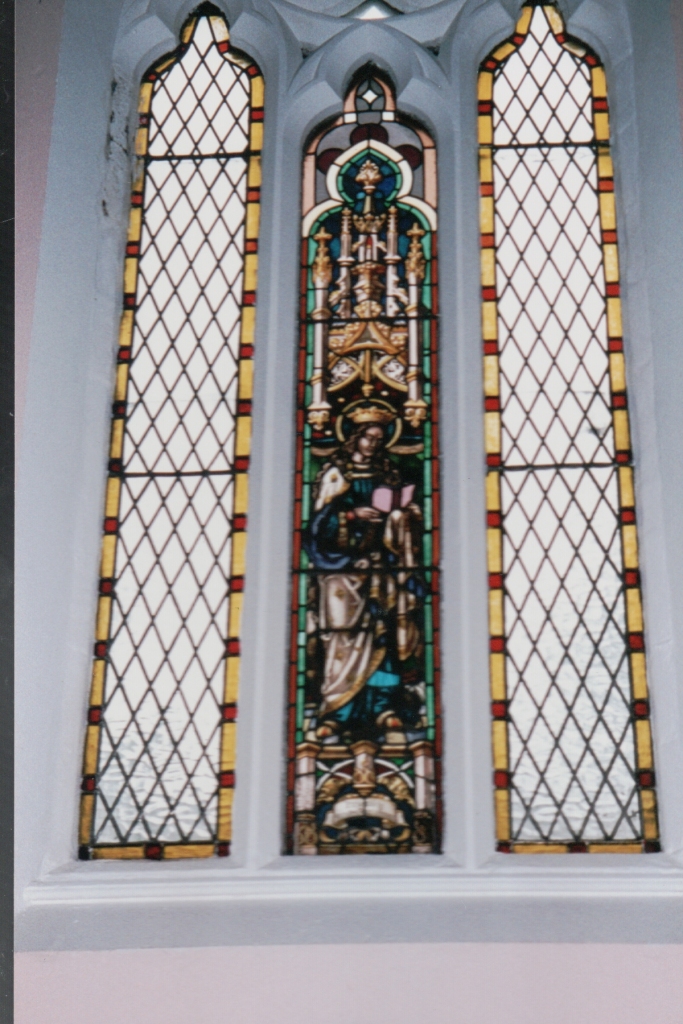This blog post is about the contradiction that is my maternal great, great grandfather, Francis Armour. Francis and his wife Elizabeth McDaid were wealthy enough to have a stained glass window put in their adopted Church in Scotland (they were both originally from County Donegal in Ireland) and I have Elizabeth’s Catholic Epistles and Gospels into which Elizabeth pasted Francis’ glowing obituary, but they also had to apply for poor relief due to poverty.
As is usual with my family history blogposts I will look at Francis’ major life events as officially registered and I’ll then discuss his story.
Birth, marriage and death certificates for Roman Catholics started in Ireland in 1864 – Francis and Elizabeth’s younger children appear in those records but Francis and Elizabeth were born and married before those records started. Unfortunately also the County Donegal Church records have not survived which recorded Francis and Elizabeth’s birth and marriage.
In May 1882 Elizabeth took unwell and was treated at Paisley Asylum (and also at an asylum in Ireland) and so Francis had to apply for poor relief – thankfully there is an excellent heritage centre in Paisley which has retained Francis’ poor relief application.
Francis confirmed on 16 May 1882 that he was then aged 48 and Elizabeth was aged 46. Francis confirmed that he and Elizabeth were married about 25 years ago by Reverend Father McGill in Buncrana. Francis also confirmed that he had moved from Ireland to Johnstone 4 and a half years previously with him moving by himself initially and his family following him shortly afterwards.
In the 1881 census Francis, a flax heckler, and Elizabeth, were living at 10 Mary Street, Johnstone with their children Robert, John, William (my great-grandfather), Mary, Francis and Elizabeth. In the 1891 census Francis, a flax dresser, and Elizabeth were living at 21 Russell Street, Johnstone with their children William, Mary, Francis and Elizabeth.
On 31st December 1895 Francis died at 21 Russell Street from cardiac debility and pleurisy for 6 days and Francis was buried at Abbey Cemetery, Elderslie on 2nd January 1896.

Here are some of Francis’ contradictions.
We’ve seen above that Francis and Elizabeth were so poor in 1882 that, when Elizabeth took ill, they had to apply for poor relief. However, when Francis died in 1896, he left behind £320 5s 0d which was equivalent to £26,255.78 in 2017!
When Francis died he had only £1 in the house, and £8-worth of furniture in the house, but he had £41 8s 4d in a Post Office Savings account, £205 6s 8d invested in Johnstone Cooperative Society Limited, an insurance policy with the Prudential Assurance Company Limited that would pay out £50, £12 10s 0d invested in the Paisley Cooperative Manufacturing Society Limited and £2 payable by the Johnstone Flax Mill Friendly Society.
Francis’ obituary pasted into his his wife’s Catholic Epistles and Gospels reads as follows:
‘By the death of Mr Francis Armour, which occurred on 30th December, the Catholics of Johnstone have sustained a severe loss, and the place he has left vacant will be hard to fill.
A man of genial and sympathetic disposition, he took a deep interest in any work which would benefit the poor. For the last number of years he was president of the local conference of the St Vincent De Paul Society, and he faithfully carried out its precepts, as no deserving case was ever brought under his notice without receiving prompt attention. He also took a deep interest in the co-operative movement, which owes much of its success in this town to his untiring energy. He leaves a widow and grown-up family, for whom much sympathy is felt in their sad bereavement.
A large number of mourners followed his remains to the grave on Thursday, 2nd inst.. Father Davidson read the burial service, and as the coffin was lowered into the grave it was felt that a good and faithful servant had gone to his reward. RIP.’
Francis and Elizabeth installed a beautiful stained glass window in St Margaret’s Church, Johnstone:

In conclusion: I do wonder personally if Francis was so involved in investing both financially and of his time in their local adopted community that he didn’t have the finances left for his family?
Sources: Scotland’s People website for censuses, death certificates and inventory on death, photos of St Margaret’s Church taken personally by Jacqueline Hunter, Elizabeth McDaid’s Catholic Epistles and Gospels in personal possession of Jacqueline Hunter, Paisley Heritage Centre for Francis Armour’s poor relief application, Renfrewshire Council Parks and Cemeteries department for Francis Armour’s place of burial and the National Archives in London for a currency converter.